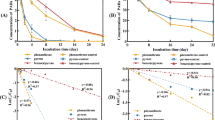Abstract
For the first time the production of an emulsifying agent during phthalic, 2,2′-diphenic and α-hydroxy-β-naphthoic acids, phenanthrene, anthracene, fluorene, pyrene, fluoranthene, and chrysene degradation by white rot fungus Pleurotus ostreatus was found. The emulsifying activity of the cultivation medium after degradation of these compounds was assessed. Maximal activities were found in the presence of chrysene (48.4%) and α-hydroxy-β-naphthoic acid (52.2%). Emulsifying activity inversely dependent on the water solubility of the compounds used. Versatile peroxidase was produced concurrently with the emulsifying agent.

Similar content being viewed by others
References
Bezalel L, Hadar Y, Cerniglia C (1997) Enzymatic mechanisms involved in phenanthrene degradation by the white rot fungus Pleurotus ostreatus. Appl Environ Microbiol 63:2495–2501
Bezalel L, Hadar Y, Fu P, Freeman J, Cerniglia C (1996) Initial oxidation products in the metabolism of pyrene, anthracene, fluorene and dibenzothiophene by the white rot fungus Pleurotus ostreatus. Appl Environ Microbiol 62:2554–2559
Bezalel L, Hadar Y, Fu P, Freeman J, Cerniglia C (1996) Metabolism of phenanthrene by the white rot fungus Pleurotus ostreatus. Appl Environ Microbiol 62:2547–2553
Bogan B, Lamar R (1995) One-electron oxidation in the degradation of creosote polycyclic aromatic hydrocarbons by Phanerochaete chrysosporium. Appl Environ Microbiol 61:2631–2635
Böhmer S, Messner K, Srebotnik E (1998) Oxidation of phenanthrene by a fungal laccase in the presence of 1-hydroxybenztriazole and unsaturated lipids. Biochem Biophys Res Commun 244:233–238
Bradford MM (1976) A rapid and sensitive method for the quantitation of microorganisms qualities of protein utilizing the principle of protein–dye binding. Anal Biochem 72:248–254
Cerniglia C (1993) Biodegradation of polycyclic aromatic hydrocarbons. Biodegradation 3:351–368
Cooper D, Goldenberg B (1987) Surface-active agents from two Bacillus species. Appl Environ Microbiol 53:224–229
Das P, Mukherjee S, Sen R (2008) Improved bioavailability and biodegradation of a model polyaromatic hydrocarbon by biosurfactant producing bacterium of marine origin. Chemosphere 72:1229–1234
Deziel E, Paquette G, Villemur R, Lepine F, Bisaillon J-G (1996) Biosurfactant production by a soil Pseudomonas strain growing on polycyclic aromatic hydrocarbons. Appl Environ Microbiol 62:1908–1912
Garcia-Junco M, De Olmedo E, Ortega-Calvo J-J (2001) Bioavailability of solid and non-aqueous phase liquid (NAPL)-dissolved phenanthrene to the biosurfactant-producing bacterium Pseudomonas aeruginosa 19SJ. Environ Microbiol 3:561–569
Heinfling A, Martinez M, Martinez A, Bergbauer M, Szewzyk U (1998) Purification and characterization of peroxidases from dye-decolorizing fungus Bjerkandera adusta. FEMS Microbiol Lett 165:43–50
Jager A, Croan S, Kirk K (1985) Production of ligninase and degradation of lignin in agitated submerged cultures of Phanerochaete chrysosporium. Appl Environ Microbiol 50:1274–1278
Kanaly R, Harayama S (2000) Biodegradation of high-molecular-weight polycyclic aromatic hydrocarbons by bacteria. J Bacteriol 182:2059–2067
Kotterman M, Rietberg H-J, Hage A, Field J (1998) Polycyclic aromatic hydrocarbon oxidation by the white-rot fungus Bjerkandera sp. strain BOS55 in the presence of nonionic surfactants. Biotech Bioeng 57:220–227
Lu X, Zhang X, Li G, Zhang W (2003) Production of biosurfactant and its role in the biodegradation of oil hydrocarbons. J Environ Sci Health A Tox Hazard Subst Environ Eng 38:483–492
Mahanty B, Pakshirajan K, Dasu V (2006) Production and properties of a biosurfactant applied to polycyclic aromatic hydrocarbon solubilization. Appl Biochem Biotechnol 134:129–141
Moen M, Hammel K (1994) Lipid peroxidation by the manganese peroxidase of Phanerochaete chrysosporium is the basis for phenanthrene oxidation by the intact fungus. Appl Environ Microbiol 60:1956–1961
Moore M, Livingstone D, Widdows J (1989) Hydrocarbons in marine mollusks: biological effects and ecological consequences. In: Varanishi U (ed) Metabolism of polycyclic aromatic hydrocarbons in the aquatic environment. CRC Press, Boca Raton, FL, pp 291–328
Nikitina V, Marinina N, Boldyrev V, Ozerov R (2003) Characterization of some wild-growing strains of Veshenka with the purpose of their use in practical fungi-growing. Bull Bot Gard Saratov State Univ 2:169–176
Niku-Paavola M-L, Karhunen E, Salola P, Paunio V (1988) Ligninolytic enzymes of white-rot fungus Phlebia radiate. Biochem J 254:877–884
Pahlman R, Pelkonen O (1987) Mutagenicity studies of different polycyclic aromatic hydrocarbons: the significance of enzymatic factors and molecular structure. Carcinogenesis 8:773–778
Pozdnyakova N, Rodakiewicz-Nowak J, Turkovskaya O, Haber J (2006) Oxidative degradation of polyaromatic hydrocarbons catalyzed by blue laccase from Pleurotus ostreatus D1 in the presence of synthetic mediators. Enzyme Microbe Technol 39:1242–1249
Reddy C (1995) The potential for white-rot fungi in the treatment of pollutants. Curr Opin Biotechnol 6:320–328
Ruiz-Duenas F, Camarero S, Perez-Boada M, Martinez M, Martinez A (2001) A new versatile peroxidases from Pleurotus. Biochem Soc Transact 29:116–122
Song H-G (1999) Comparison of pyrene degradation by white rot fungi. World J Microbiol Biotechnol 15:669–672
Wang R-Y, Liu J-X, Huang H-L, Yu Z, Xu X-M, Zeng G-M (2008) Effect of rhamnolipid on the enzyme production of two species of lignin-degrading fungi. Hunan Daxue Xuebao/J Hunan Univ Nat Sci 35:70–74
Acknowledgments
We thank Dr. V. E. Nikitina for kindly providing us with P. ostreatus D1. We are grateful to Dmitry N. Tychinin for his assistance in preparation of the English text of this paper. This work was supported by the federal target-oriented programme “Issledovaniya I razrabotki po prioritetnym napravleniyam razvitiya nauchno-tekhnologicheskogo kompleksa Rossii na 2007–2012 gody” (Research and Developments on Priority Directions in the Development of Russian’s Science and Technology Complex for 2007–2012)—State contract no. 02.512.11.2210.
Author information
Authors and Affiliations
Corresponding author
Rights and permissions
About this article
Cite this article
Nikiforova, S.V., Pozdnyakova, N.N. & Turkovskaya, O.V. Emulsifying Agent Production During PAHs Degradation by the White Rot Fungus Pleurotus Ostreatus D1. Curr Microbiol 58, 554–558 (2009). https://doi.org/10.1007/s00284-009-9367-1
Received:
Revised:
Accepted:
Published:
Issue Date:
DOI: https://doi.org/10.1007/s00284-009-9367-1




